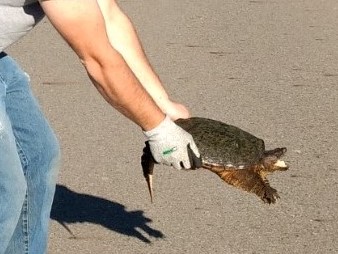The Proper Way to Help A Turtle Across the Road

A common act of charity on Michigan roads is the occasional stop to help a turtle cross the street so it doesn’t become a road pancake. This is easy enough when the turtle is a small painted box turtle, but it can get a little sketchy when it is a very large, mature snapping turtle. Snapping turtles are noted for not only their size but their ornery temperament; if you’ve ever had a turtle hiss at you, it was probably a snapper. Their powerful jaws can easily break—and in some cases completely sever—a human finger. They can be very aggressive if they feel cornered. Snappers are not to be trifled with by those unfamiliar with how to deal with them.
But even so, we can’t just stand by and allow our belligerent reptilian friends to get smooshed by traffic. Snappers have extremely long life span—most snappers you see crossing the road are going to be females; in most cases they waited at least 35 years to get as big as they are to be able to lay eggs. And now they just need a little bit of help scooting out of the way of traffic. So then, what is the proper way for moving a snapping turtle across the road?
First, you want to make sure it is a snapping turtle you are dealing with. Snappers are distinguished by their very large size and three bumpy ridges on their shell. They have long claws and a long tail, which is usually protruding from the back of the shell.
If it is a snapper, the two most important considerations in moving it are (1) making sure you do so in such a way that does not hurt the turtle, and (2) protecting your hand from getting your finger bitten off.
Many people, anxious to stay away from the turtle’s fearsome jaws, will instinctively try to grab or carry the turtle by the tail. This is a bad idea; the bones in the turtle’s tail are literally the continuation of its spine, so to tug the turtle’s tail or (worse) to carry it by the tail puts tremendous pressure on the turtle’s spine and can injure it. It’s best to grab the turtle by the shell, while supporting it’s underside with your fingers, as Dave demonstrates below; this ensures you are not putting stress on the turtle’s spine and are giving it’s heavy body the proper support:
But where is the best place to grab the turtle to avoid getting bitten? This is important, as the neck of a snapping turtle is extremely flexible and capable of extending quite a bit out from it’s shell. Most snappers can bend their necks and reach a considerable distance behind them. It is important, therefore, to keep your fingers out of reach. Dave recommends grabbing the turtle at the abdomen just in front of its back legs, as seen below:
Now you should be fully educated on the proper method of snapping turtle removal! Good luck!